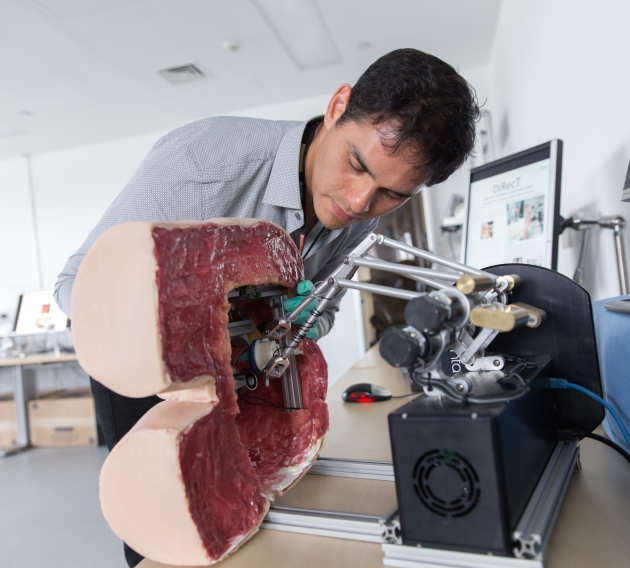Haptics refers to the sense of touch and the associated perception and manipulation of objects that result from any form of interaction involving touch. Haptic technology aims to recreate the sense of touch via a device (haptic device) that serves as an interface between a user and a computer system.
We use haptic technology to recreate the interactions between a clinician and the human body during medical examinations and surgical procedures, either through direct palpation of the anatomy, or indirectly through the manipulation of instruments such as endoscopes, catheters and guidewires. Studying and understanding the biomechanical behaviour of organs / tissues and their deformation during such interaction and the dexterous manipulations performed by clinicians are important components of this research theme.
Research objectives
- Study expertise of clinicians from different specialties to understand dexterous manipulations performed during a clinical examination or procedure and infer competent /expert performance
- Develop innovative haptics rendering algorithms allowing real-time interaction and recreation of forces, torques and vibrations present during a clinical examination or procedure
- Adapt off-the-shelf haptic devices or develop bespoke haptic devices to address the needs for adequately recreating interactions and dexterous manipulations in a clinical examination or procedure
- Employ state-of-the-art high performance computing algorithms to satisfy the requirements of haptic interaction for real-time simulation of clinical examinations or procedures
- Integration of hardware and software components into simulator systems conducting rigorous validation studies
Examples
Direct - Digital Rectal Examination Haptics Training System

This innovative haptics-enabled simulator helps train doctors and nurses learn how to perform a Digital Rectal Examination (DRE) by accurately providing a realistic haptic interface and simulation software that recreates both the feel and interactions of performing a DRE on a patient, as well as providing real-time formative and summative feedback on the examination technique.
Find out more about the DiRECT system.
VCSim – Virtual Catheterisation Simulator
Minimally invasive cardiovascular interventions are performed by inserting long, thin, flexible surgical instruments (catheters and guidewires) through a patient's femoral artery near the groin al the way to the heart. Effective and safe performance of these interventions requires excellent instrument manipulation skills, which are mainly gained by practicing on real patients.
VCSim combines haptic technology with fluoroscopic view control and real-time VR simulation software with the aim of providing an effective and realistic training system for endovascular and cardiovascular interventionists. The haptic device tracks the catheter and guidewire, allowing them to be translated and rotated. It also applies force feedback to simulate the interactions between the tools and the vasculature..
Key publications
Alejandro Granados, Niels Hald, Aimee Di Marco, Shahla Ahmed, Naomi Low-Beer, Jenny Higham, Roger Kneebone, Fernando Bello. Real-Time Visualisation and Analysis of Internal Examinations – Seeing the Unseen. MICCAI 2014;8673:617-625. (Chapter 3)
Korzeniowski P, Martinez-Martinez F, Hald N, Bello F et al, 2014, Simulation of Catheters and Guidewires for Cardiovascular Interventions Using an Inextensible Cosserat Rod, 6th International Symposium on Biomedical Simulation (ISBMS), Publisher: SPRINGER INT PUBLISHING AG, Pages: 112-121, ISSN: 0302-9743
Luboz, V., et al. (2008). A virtual environment for core skills training in vascular Interventional Radiology. Biomedical Simulation, Proceedings 5104: 215-220.